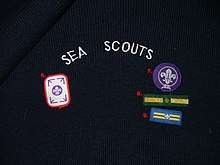Sea Scouts (The Scout Association)
Sea Scouts were first formed in the United Kingdom in 1909 as a branch of The Scout Association and have been a feature of the Scouting movement ever since.[1] The branch has a particular emphasis on boating and water-based activities, such as sailing, canoeing, motorboating and navigation.
| Sea Scouts | |||
|---|---|---|---|
.png) Ensign of the Royal Navy Recognised Sea Scouts | |||
| Owner | The Scout Association | ||
| Age range | 10–14 | ||
| Founded | 1909 | ||
| |||
| Explorer Sea Scouts | |||
|---|---|---|---|
| Age range | 14–18 | ||
| |||
Sea Scouts are aged 10 to 14, and Explorer Sea Scouts 14 to 18. Sea Scout Groups often have younger members in Beaver Scout and Cub Scout sections. Although they are not counted in Sea Scout numbers, they are allowed to wear the Royal Navy Recognition Badge if their Group has that recognition.
Royal Navy Recognition
In the United Kingdom there are approximately 400 Sea Scout Groups and 101 of these are recognised by the Royal Navy.[2] The scheme began in 1919 following the efforts of Scouts during World War I in support of the armed forces, through service as coast watchers, first aiders, fire fighters and messengers.[2] Groups that apply for Recognition are inspected by a Royal Navy officer. Providing there is a vacant position, Groups that pass the inspection and meet the exacting standards of the Royal Navy are awarded Recognition on behalf of the Admiralty Board.
Recognised Groups are entitled to fly a Red Ensign and blue pennant, both defaced with a Scout Arrowhead and Admiralty Crown. Members may also wear the Royal Navy Recognition badge on uniform.[3] Sea Scouts may go to sea with the Royal Navy, visit military establishments and use facilities at HMS Excellent, such as the Royal Navy Sailing Centre and the Youth Training Ship, HMS Bristol.
Three events occur annually for Royal Navy Recognised Sea Scouts, a swimming gala at HMS Raleigh, a football competition at HMS Excellent, and a summer "camp" aboard HMS Bristol. Another camp is held for Sea Explorers in October of each year.
Uniform

The official uniform of a Sea Scout is as follows:[4]
- Dark blue woollen Sea Scout jersey or a light blue long sleeve shirt or blouse
- Smart navy blue trousers or skirt
- Group scarf
- Leather Scout belt and buckle (optional)
- Seaman's Class II white cap with 'Sea Scouts' tallyband (officially known as a cap tally)
- White lanyard with bosun's call (Sea Scout Patrol Leaders only. Optional. Worn on a chain in the Royal Navy as a lanyard was used to fire guns.)
The official uniform of an Explorer Sea Scout is as follows:[5]
- Light blue long sleeve shirt or blouse
- Explorer Scout Unit scarf and woggle (a Group scarf may be worn if specified in the Partnership Agreement) or blue tie
- Smart navy blue trousers or smart navy blue skirt
- Scout belt / Explorer Belt and buckle
- Seaman's Class 2 round cap with 'Explorer Sea Scout' tallyband or peaked officer's cap with white top and Sea Scout cap badge (each Explorer Scout Unit to wear the same headwear option).
Centenary
The centenary of Sea Scouting was celebrated in 2009. The Centenary Sea Scout Jamboree was held in August of that year, at the Holme Pierrepont National Watersports Centre in Nottinghamshire. Around 3,000 Sea Scouts participated in the event and came from around the world.[6]
See also
- Royal Navy Recognised Sea Scouts
- Sea Scout
- RRS Discovery — the ship of Scott's first expedition to the Antarctic, later used as a Sea Scout training ship
References
- "The Passing Years" (PDF). The Scout Association. December 2004. Retrieved 12 December 2006.
- "Scouting Afloat: Sea Scouting in the UK" (PDF). The Scout Association. November 2004. Retrieved 29 April 2014.
- "Royal Navy Recognition Scheme" (PDF). The Scout Association. March 2003. Retrieved 12 December 2006.
- "Rule 10.8: Sea Scout Uniform". Policy, Organisation and Rules. The Scout Association. 2005. Retrieved 12 December 2006.
- "Rule 10.12: Explorer Sea Scout Uniform". Policy, Organisation and Rules. The Scout Association. 2006. Retrieved 16 October 2010.
- "Sea Scouts celebrate centenary in Notts". Nottingham Post. 1 August 2009. Retrieved 11 September 2009.